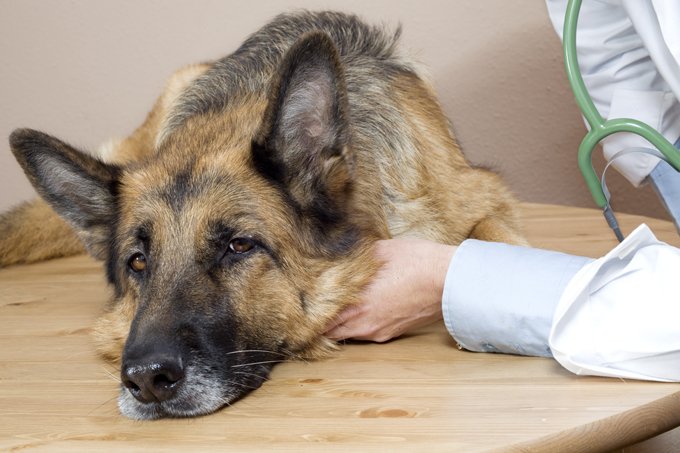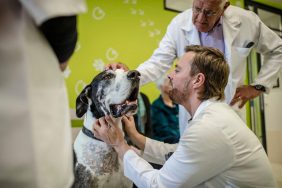This article is brought to you courtesy of the National Canine Cancer Foundation.
See more articles on canine cancer.
Donate to the Champ Fund and help cure canine cancer.
Description
Apocrine glands are the major type of sweat glands in dogs. These lesions are quite common. Golden Retrievers, Collies, German Shepherds, Old English Sheepdogs and Cocker Spaniels are reported to be highly predisposed. Around 70% of these apocrine tumors are non-malignant in nature. But the malignant ones tend to be locally aggressive and have a high potential to spread to the regional lymph nodes and lungs.
They have been categorized into apocrine adenoma (complex and mixed), apocrine ductal adenoma, apocrine carcinoma (complex and mixed), apocrine ductal carcinoma, ceruminous adenoma, ceruminous gland carcinoma, anal gland sac adenoma and anal gland sac carcinoma by World Health Organization (WHO).
Depending on their location, they have been classified as glandular (arising from the gland) and ductular (arising from the ducts). Malignant tumors are generally seen in older dogs. They are solitary, firm and well differentiated tumors. The nodules are generally 0.5-4cm in diameter located in the dermis (mesodermic layer of the skin) and sub-cutis (deeper part of the dermis). The inflammatory malignant tumors are poorly circumscribed. They generally appear as ulcerative plaque. These lesions are highly proliferative. Since they occur in the axillary (armpit) and inguial (situated in the region of the groin or in either of the lowest lateral regions of the abdomen) regions, they are mostly mistaken for pyotraumatic dermatitis (skin lesions made worse by biting, licking, constant chewing or scratching).
Types of apocrine sweat gland carcinomas:
Apocrine adenomas (complex and mixed)
If the lesions are apocrine adenomas the clinical signs consist of lumps or soft bulges above the neighboring skin. Some lesions are multilobulated and cystic. The lobules are filled with a clear fluid. The cysts also have fine interlobular separations of connective tissue. They are common in the dogs. Breeds between 8-11 years have a higher incidence. Lhasa apso, Old English sheepdog, Collie, Shih tzu and Irish setters are highly predisposed. No sex predilection has been noted. They mostly arise on the head and neck. They grow slowly and there is no chance of recurrence following surgical extirpation.
Apocrine ductal adenoma
This is a non-malignant lesion. These tumors develop on the head, thorax, abdomen and back. Apocrine ductular adenomas occur in dogs in the age group of 6-11 years. They are found within the deep dermis and the sub-cutis and are well-differentiated. They are multilobulated and the tumor may consist of cysts of different sizes. These tumors are also slow growing.
Apocrine carcinoma (complex and mixed)
In apocrine carcinomas, the lesions have different clinical presentations. The tumors are generally nodular, intradermal, and sub-cutaneous masses of variable sizes. They can be diffuse, ulcerative, erosive dermatitis that is often referred to as inflammatory carcinoma. The nodules are of various sizes. They vary from less than 1cm to many centimeters in diameter. It appears as an expansile skin tumor that aggravates in a centrifugal manner (aggravating in a direction away from the axis or center from a central focus of ulceration. There might be severe edema. Fibrosis (formation or development of excess fibrous connective tissue) is generally observed at the periphery of the masses. They generally occur in the inguinal and axillary areas. Their growth is quite variable. Inflammatory carcinomas aggravate with a lightening speed and metastasize to regional lymph nodes and lungs. However, complex and apocrine carcinomas generally grow slowly and have a diminished metastatic potential.
Apocrine ductal carcinoma
They are poorly differentiated and very aggressive in nature. It is often ulcerated and proliferative at the periphery. They usually grow slowly and surgical extirpation is the treatment of choice. These tumors do not have a high metastatic potential.
Ceruminous adenoma
It is a non-malignant lesion. It is found in the age group of 4-13 years. Dogs at an increased risk include Cocker spaniel and Shih tzu. They are more common in the age group of 5-14 years. Cocker spaniels are at an increased risk. They are found within the ear canal and also the vertical ear canal. They tend to be exophytic (growing outward). Ulceration and secondary infection are common. In Cocker spaniels which have a higher incidence, it is very difficult distinguishing non-malignant neoplasms from the hyperplastic polypoid otitis externa (neoplastic inflammation of the outer ear and ear canal). These lesions generally have a dark brown appearance. Although ceruminous adenomas are slow growing, they cannot be surgically excised. Therefore ablation (removal of the material from the surface of an object by vaporization, or other erosive processes) of the ear may be necessary.
Ceruminous gland carcinoma
These tumors are relatively common in dogs. Dogs between 5-14 years of age have a higher incidence. Cocker spaniels are highly predisposed. Castrated (spayed) male dogs have a predilection for developing ceruminous carcinomas. They are usually proliferative, erosive and ulcerative growths. But they do not invasive and they rarely ruin the cartilage of the ear canal. It infiltrates the dermis and lymphatics (network that contains a clear fluid called lymph) and metastasizes to the parotid lymph node (lymph nodes found near the parotid gland). Surgical extirpation results in total ablation of the ear.
Diagnostic techniques
Like any other cancer, the diagnostic techniques consist of a fine needle aspiration for microscopic examination of cell samples also called ‘cytology’. But histopathology is more important since the microscopic examination of specially prepared and stained tissue sections offers a better diagnosis. This is done at a specialized laboratory where the slides are examined by a veterinary pathologist. This information helps in determining the prognosis. It is also useful in deciding the course of action. Histopathology also rules out the presence of other cancers.
Treatment
The treatment of choice for sweat gland and ceruminous gland adenocarcinomas is complete surgical excision. If it is a neoplasm of the ear canal, complete ear ablation may be necessary.
If the margins of the incision are free of tumor cells no additional treatment is required. But if surgical extirpation is not possible, vets opt for curative-intent radiation therapy since most of these tumors respond well to radiotherapy.
Prognosis
Prognosis is sorely dependent on histopathological findings.
Other types include:
Anal sac gland adenoma
This is a non-malignant lesion, but found very rarely in dogs. The lesions develop from the apocrine glands of the anal sac. It is very difficult to distinguish them from their malignant counterparts. There is not much information available on these tumors.
Anal sac gland carcinoma
This is a malignant lesion that develops from the apocrine secretory epithelium found in the wall of the anal sac. It is quite common in dogs. Breeds in the age group of 5-15 years are predisposed. Dogs at higher risk include English cocker spaniel, German shepherd, English springer spaniel and mixed breeds have a predilection. They are less common in dogs than their benign counterparts accounting for 2% of all skin lesions. It is perhaps the most common malignancy in female dogs in this region. It has a metastatic potential ranging from 46%- 96% at the time of initial presentation. Regional sublumbar lymph nodes (lymph node located under the vertebral column) metastasis is perhaps the most common. An investigation conducted on 113 dogs suggests the presence of hypercalcemia (presence of high calcium levels in the blood) in approximately 27% of cases.
Symptoms
Depending on how big the mass is, clinical signs include perianal discomfort, swelling, hypercalcemia, polyuria (urge to urinate more frequently), polydipsia (increased levels of thirst), anorexia (symptom of poor appetite) from the superior to the inferior aperture of the pelvis), vomiting and muscle weakness. But in case the disease has metastasized to the sublumbar lymph nodes, a lower back pain and postural abnormalities are noticed.
Diagnostic techniques
The physical examination consists of rectal palpation, complete blood count, serum biochemistry profile, urinanalysis and evaluation for possible lymphadenopathy. A fine needle aspirate is useful in ruling out infection or inflammatory disease of the anal sac. Vets should note that anal sac lesions may be secondarily infected or inflamed. Staging is another very important aspect, since it helps in determining the rate of metastasis. Examinations like thoracic radiographs are essential for evaluating any pulmonary or mediastinal involvement. Ultrasonography determines the size of regional lymph nodes and the echogenecity (the characteristic ability of an organ or tissues to reflect ultrasound waves and produce echoes) of other abdominal organs especially liver and spleen. Computed tomography (CT) will give the vets a more precise idea about abdominal involvement. Sometimes CT reveals pulmonary metastasis.
If the clinician sees any lameness or pain in the bone, he should conduct a radiography or nuclear scintigraphy (non invasive innovative technique). This helps to rule out bone metastasis. Depending on the patient’s calcium levels and renal function, the doctor may opt for aggressive medical management.
Treatment
Surgery is the treatment of choice for most dogs with apocrine gland tumors. Apocrine gland anal sac adenocarcinoma is very proliferative, therefore aggressive extirpation is recommended. With surgery alone, there is a very high chance of recurrence. It is very difficult to obtain wide surgical margins, owing to proximity to the rectum. The disease is quite advanced at the time of diagnosis only. Lymph nodes is the most common site for metastasis. Along with the lesion, the enlarged lymph node should also be removed. Post surgery chemotherapy or curative-intent radiation therapy are considered. Since this is a hypersensitive area, surgery may result in several complications like wound dehiscence (premature opening of a wound along surgical suture), incontinence (involuntary discharge of urine and feces) and infection. Hemorrhage is the most common complication associated with lymph node removal.
Curative-intent radiation or chemotherapy may be used in combination or as the sole treatment. In most of the cases, curative-intent radiation works best when the volume of the tumor has been reduced to a microscopic level. Therefore it is most effective as an adjunct to surgery. It consists of 15-19 treatments over a 3-week to 6-week period. Radiation therapy begins two weeks after the surgery. As a result of the metastasis to regional lymph nodes, it is recommended that sublumbar be irradiated. Side effects include colitis, moist desquamation (shedding of the outer layers of the skin) alopecia (loss of hair from the head and the body). However, these are temporary, so there is not much cause for concern. They would be gone 2-4 weeks after the therapy. But certain side effects surface long after the therapy is over. These include chronic colitis and rectal stricture (abnormal narrowing of blood vessels). But none of the complications have been reported to be life-threatening.
Full course curative intent radiation is used for tumors not amenable to surgery. Chemotherapy combined with surgery has been used in a few cases, but their efficacy in the treatment of apocrine gland anal sac adenocarcinoma has not been established yet. The platinum drugs, cisplastin, carboplatin and actinomycin-D have showed limited progress in tumor management.
Prognosis
According to a report, dogs undergoing surgery showed a median survival of 548 days. Dogs treated with a combination of surgery, curative intent radiation and mitoxantrone chemotherapy have been reported to survive the longest. Fifteen dogs treated in this manner showed a median survival of 287 days and an overall survival of 956 days. Complete or near complete removal can warrant drop in hypercalcemia levels. But if it recurs after surgery, it hints at metastasis. Pulmonary metastasis and tumors more than 10cm are associated with a poor prognosis.
References
Withrow and MacEwen’s Small Animal Clinical Oncology – Stephen J. Withrow, DVM, DACVIM (Oncology), Director, Animal Cancer Center Stuart Chair In Oncology, University Distinguished Professor, Colorado State University Fort Collins, Colorado; David M. Vail, DVM, DACVIM (Oncology), Professor of Oncology, Director of Clinical Research, School of Veterinary Medicine University of Wisconsin-Madison Madison, Wisconsin
Tumors in Domestic Animals – Donald J. Meuten, DVM, PhD, is a professor of pathology in the Department of Microbiology, Pathology, and Parasitology at the College of Veterinary Medicine, North Carolina State University, Raleigh
Apocrine Gland Adenocarcinoma of the Anal Sac: Catch it early to improve prognosis – Km L. Cronin, DVM, Dipl.ACVIM









